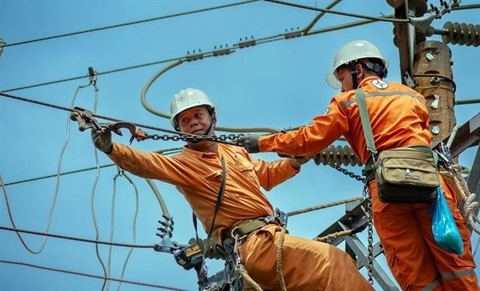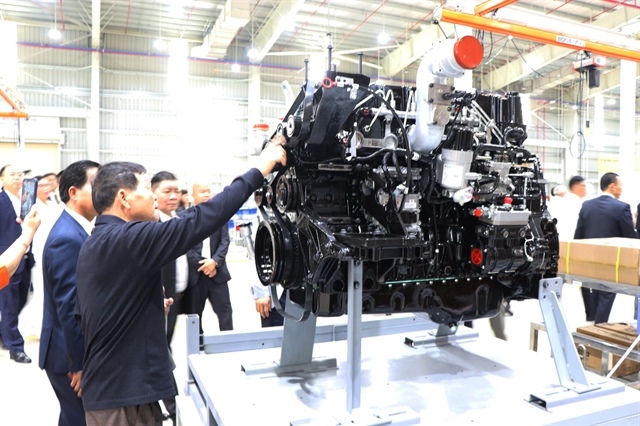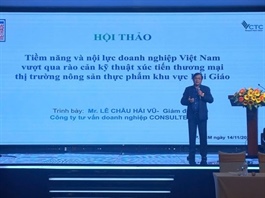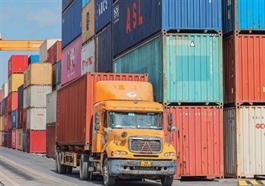Amending the Law on Electricity to unlock resources for energy security and net zero emissions
Amending the Law on Electricity to unlock resources for energy security and net zero emissions
The draft amendment to the Law on Electricity, which is on the agenda at the current session of the National Assembly, will be a bold step for Việt Nam towards ensuring national energy security and achieving net zero emissions by 2050, through creating a more favourable mechanism to break down the barriers of investments in the energy sector.

A wind farm in Gia Lai Province. Amending the Law on Electricity becomes pressing to provide a vision and set out a roadmap towards energy security and net zero by 2050. — VNA/VNS Photo Vũ Sinh |
The General Secretary of the ruling party, Tô Lâm, has emphasised the necessity of amending the Law on Electricity in response to energy infrastructure requirements, which are considered a key to creating socio-economic development breakthroughs.
While Việt Nam is facing the pressing question of how to ensure adequate energy supply for the country’s rapid socio-economic growth and sustainable development, amending the Law on Electricity is a way to provide a vision and set out a roadmap towards energy security and net zero goals for 2050, according to Party General Secretary Lâm.
The Law on Electricity was promulgated in 2004 and had undergone four amendments during the past two decades, Minister of Industry and Trade Nguyễn Hồng Diên said. To date, the law had been shown to have shortcomings and was unable to resolve newly arising problems.
Without guaranteed and transparent mechanisms for energy development, it would be difficult for Việt Nam to meet the rising demand for electricity, Diên said.
He cited statistics showing that by 2030, or around five years from now, Việt Nam must double the current total capacity of electricity production to 150,524MW, and that the country would need an energy capacity five times higher by 2050, equivalent to 530,000MW.
To achieve the goal of carbon neutrality by 2050, Việt Nam would have to focus on developing renewable energy and accelerating the energy transition away from fossil fuels. The country also needed to have a transparent and compatible legal system, he said.
“Amending the Law on Electricity aims to promptly institutionalise the Party’s new policies. At the same time, it aims to tackle bottlenecks in the existing regulations to ensure consistency and promote the sustainable and efficient development of the power industry to meet rapidly increasing demand, and fundamentally change the structure of power sources to achieve net zero by 2050, as well as ensuring the national energy security,” Diên said.
The draft amendments to the Law on Electricity with nine chapters and 130 articles will focus on six major issues, including planning and investing in electricity development to ensure energy security, promoting the development of renewable and new energy, completing regulations on electricity operation, pricing mechanisms for a competitive electricity market, encouraging energy savings and efficiency, and ensuring safety.
Unlocking resources
Việt Nam’s electricity market is facing numerous challenges, especially in attracting investments in independent power projects on the path towards energy security and carbon neutrality.
The draft amendment to the Law on Electricity is expected to create a legal framework for enterprises, credit and financial institutions to invest in the energy sector, especially in offshore wind power and LNG power projects, according to the Ministry of Industry and Trade.
Currently, the implementation of electricity generation sources following the Eighth National Power Development Plan (PDP8) is slower than expected, which might affect national energy security.
According to Diên, Việt Nam is committed to achieving carbon neutrality by 2050, meaning that renewable energy must be developed rapidly.
The absence of a detailed legal framework for renewable and other types of energy such as hydrogen, green ammonia and nuclear power is a big problem. The PDP8 was revealed nearly one and a half years ago, but there have been no new proposals for energy projects due to the lack of detailed regulations and policies.
"If Việt Nam does not promptly issue appropriate and feasible mechanisms and policies, it will be impossible to attract investments in the energy sector. As a result, it will be difficult to meet the country’s energy demand," Diên said.
“It becomes pressing for Việt Nam to establish a feasible and appropriate legal framework to attract investors in electricity generation and the grid.”
Diên also said that nuclear power should be included in the law to set a foundation for its future development.

Workers of Việt Nam Electricity are checking a transmission line. Việt Nam needs huge investments in electricity generation and grid to meet the rising demand. — VNA/VNS Photo |
An independent energy consultant, Phan Xuân Dương, estimated that under PDP8, Việt Nam would need around US$12 billion each year to invest in electricity generation projects by 2030 and $18-24 billion each year in the 2030-2050 period.
The huge demand for capital could not come from the limited resources of State-owned enterprises such as Việt Nam Electricity (EVN), Việt Nam Oil and Gas Group (PVN), and Việt Nam National Coal and Mineral Industries Holding Corporation Limited (TKV).
He pointed out that a 1,500MW LNG power project would require an estimated investment of up to $2.5 billion, and around $3 billion would be needed for a 1,000MW offshore wind power project.
Thus, Dương said, it was necessary to diversify capital sources and forms of capital raising in order to effectively attract both domestic and foreign resources into electricity development.
In both the draft amendment and PDP8, the need for diversification of investments, including from State, private and public-private partnership sources has been highlighted.
Dương said that the law amendment needed to set mechanisms to attract investments in electricity generation, especially gas-fired power and offshore wind power projects.
Under PDP8, Việt Nam will develop ten additional LNG projects, which will use domestically produced gas with a total capacity of 7,900MW, and 13 projects which will use imported LNG with a total capacity of 22,542MW. Currently, only one project, Nhơn Trạch No 3 and 4, is under implementation and expected to go operational commercially in May 2025. Other projects are stuck due to roadblocks in raising credit.
To date, there had been no offshore wind power projects being implemented in Việt Nam in order to achieve a capacity of 6,000MW by 2030 as set under PDP8, Dương said. “If a strong mechanism to unlock resources for power generation is not developed, there will be a risk of failure to meet the demand.”
The draft laid out a framework for offshore wind power, but more detailed guidance was needed once the bill is passed so that offshore wind power projects could attract and realise investments, he said. The legal framework for LNG power projects would also need to be improved to attract foreign resources.
Early promulgation expected
The Government expects that the amendment to the Law on Electricity will be passed at the current session of the National Assembly, which will run until the end of November.
According to energy expert Thái Doãn Hoàng Cầu the draft amendment may not be perfect and may not anticipate all problems which might arise in the future. It also may not fully meet all requirements, multi-dimensional perspectives and different interests of all organisations and individuals involved.
For instance, there is still a shortage of detailed regulations for major policy goals such as offshore wind and nuclear power.
Although more studies and adjustments are needed, the draft amendment should be passed early to promote the development of the energy sector as well as Việt Nam’s socio-economic development.
Cầu urged the development of an appropriate electricity market mechanism as a foundation for electricity policies, pointing out that slowness in developing a competitive electricity market exists as a roadblock.
It was critical for Việt Nam to have market-based electricity pricing, he said. A more appropriate design for the electricity wholesale market was also needed in the context that Việt Nam has increasing demand for energy and has set challenging sustainability goals.
He proposed the foundation of a separate agency in charge of reforming the electricity market.
The National Assembly deputies at a debate on November 7, however, noted that the draft amendment needed to be put into careful consideration.
Deputy Nguyễn Hữu Thông of Bình Thuận Province said that regulations on the transfer of ownership of offshore wind power would be necessary to ensure national security and defence.
Deputy Nguyễn Hoàng Bảo Trân of Bình Dương Province said that in order to encourage the development of new types of green energy such as hydrogen and ammonia, the bill should detail incentive policies like financial support and preferential loans and taxes to encourage investors and promote technology transfer.
With a commercial electricity output of 250 billion kWh in 2023, Việt Nam’s power system ranked second in terms of scale in ASEAN and was among the top 20 in the world.
It is estimated that Việt Nam will need $135 billion worth of investments in electricity generation and the electricity grid through 2030, and $399-523 billion from 2031-2050 to implement PDP8.



























